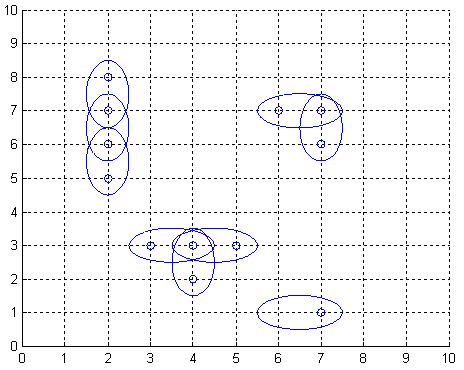POJ3020 Antenna Placement(二分图最小路径覆盖)
来源:互联网 发布:高性能计算 知乎 编辑:程序博客网 时间:2024/05/22 13:18
Description
The Global Aerial Research Centre has been allotted the task of
building the fifth generation of mobile phone nets in Sweden. The most
striking reason why they got the job, is their discovery of a new,
highly noise resistant, antenna. It is called 4DAir, and comes in four
types. Each type can only transmit and receive signals in a direction
aligned with a (slightly skewed) latitudinal and longitudinal grid,
because of the interacting electromagnetic field of the earth. The
four types correspond to antennas operating in the directions north,
west, south, and east, respectively. Below is an example picture of
places of interest, depicted by twelve small rings, and nine 4DAir
antennas depicted by ellipses covering them.

Obviously, it is desirable to
use as few antennas as possible, but still provide coverage for each
place of interest. We model the problem as follows: Let A be a
rectangular matrix describing the surface of Sweden, where an entry of
A either is a point of interest, which must be covered by at least one
antenna, or empty space. Antennas can only be positioned at an entry
in A. When an antenna is placed at row r and column c, this entry is
considered covered, but also one of the neighbouring entries
(c+1,r),(c,r+1),(c-1,r), or (c,r-1), is covered depending on the type
chosen for this particular antenna. What is the least number of
antennas for which there exists a placement in A such that all points
of interest are covered?
Input
On the first row of input is a single positive integer n, specifying
the number of scenarios that follow. Each scenario begins with a row
containing two positive integers h and w, with 1 <= h <= 40 and 0 < w
<= 10. Thereafter is a matrix presented, describing the points of
interest in Sweden in the form of h lines, each containing w
characters from the set [‘‘,’o’]. A ‘‘-character symbolises a point
of interest, whereas a ‘o’-character represents open space.
Output
For each scenario, output the minimum number of antennas necessary to
cover all ‘*’-entries in the scenario’s matrix, on a row of its own.
Sample Input
27 9ooo**oooo**oo*ooo*o*oo**o**ooooooooo*******ooo*o*oo*oo*******oo10 1***o******Sample Output
175思路
一个矩形中,有N个城市’*’,现在这n个城市都要覆盖无线,若放置一个基站,那么它至多可以覆盖相邻的两个城市。问至少放置多少个基站才能使得所有的城市都覆盖无线?
这道题跟上一道题(HDU4185)几乎是一样的,我们依然先给城市进行编号,然后用它来建立二分图,因为是要把整个城市都覆盖完
所以这个题目求的是二分图的最小路径覆盖
有一个定理:
无向二分图的最小路径覆盖 = 顶点数 – 最大二分匹配数/2
所以我们最后用顶点数减去最大二分匹配数就行了
代码
#include<cstdio>#include<cstring>#include<string>#include<set>#include<iostream>#include<stack>#include<queue>#include<vector>#include<algorithm>#define mem(a,b) memset(a,b,sizeof(a))#define inf 0x3f3f3f3f#define mod 10000007#define debug() puts("what the fuck!!!")#define ll long longusing namespace std;const int N=1000+20;int e[N][N],vis[N],match[N],n,m,num,temp[N][N];char s[N][N];int dfs(int u){ for(int i=1; i<=num; i++) { if(e[u][i]&&!vis[i]) { vis[i]=1; if(!match[i]||dfs(match[i])) { match[i]=u; return 1; } } } return 0;}int query(){ mem(match,0); int sum=0; for(int i=1; i<=num; i++) { mem(vis,0); if(dfs(i))sum++; } return sum;}int main(){ int t; scanf("%d",&t); while(t--) { mem(temp,0); mem(e,0); num=0; scanf("%d%d",&n,&m); for(int i=1; i<=n; i++) { scanf("%s",s[i]+1); for(int j=1; j<=m; j++) if(s[i][j]=='*') temp[i][j]=++num; } for(int i=1; i<=n; i++) for(int j=1; j<=m; j++) { if(s[i][j]=='*') { if(i!=1&&s[i-1][j]=='*') e[temp[i][j]][temp[i-1][j]]=1; if(j!=1&&s[i][j-1]=='*') e[temp[i][j]][temp[i][j-1]]=1; if(i!=n&&s[i+1][j]=='*') e[temp[i][j]][temp[i+1][j]]=1; if(j!=m&&s[i][j+1]=='*') e[temp[i][j]][temp[i][j+1]]=1; } } printf("%d\n",num-query()/2); } return 0;}- POJ3020 Antenna Placement(二分图最小路径覆盖)
- poj3020 Antenna Placement 二分匹配 最小路径覆盖
- POJ3020 Antenna Placement【二分图最小边覆盖】
- poj3020-Antenna Placement(最小路径覆盖问题,最大匹配)
- POJ3020《Antenna Placement》方法:无向图最小路径覆盖 匈牙利算法
- [最小路径覆盖、二分图最大匹配]Pku3020--Antenna Placement
- 【二分图+最小路径覆盖】北大 poj 3020 Antenna Placement
- poj 3020 Antenna Placement 二分图最小路径覆盖
- POJ 3020 Antenna Placement ,二分图的最小路径覆盖
- POJ - 3020 Antenna Placement 二分图 最小路径覆盖
- Poj 3020 Antenna Placement (二分图最小路径覆盖)
- POJ 3020 Antenna Placement(二分图最小路径覆盖)
- [POJ 3020]Antenna Placement[二分图最小路径覆盖]
- poj_3020 Antenna Placement(二分图最小路径覆盖)
- poj3020 Antenna Placement(无向图最小边覆盖)
- poj3020-Antenna Placement-最小点覆盖
- POJ3020--Antenna Placement--二分图最大匹配
- poj3020 Antenna Placement(二分图)
- IReport 使用记录 主报表和子报表数据传递
- 基本算法-冒泡排序
- #781 – 多个变换执行的顺序问题(Transform Order Matters)
- (笔记)类的组合,是如何析构的,及领悟
- 记录unterminated string literal报错解决
- POJ3020 Antenna Placement(二分图最小路径覆盖)
- selenium + python环境搭建
- static 相关的知识点
- Hadoop完全分布式集群安装Spark
- 数据结构第三次上机 第四章之顺序串
- 【viewPager实现轮播(代码)】
- 优化 UWP 中图片的内存占用
- web项目中各种路径的获取
- wpi http 报错


